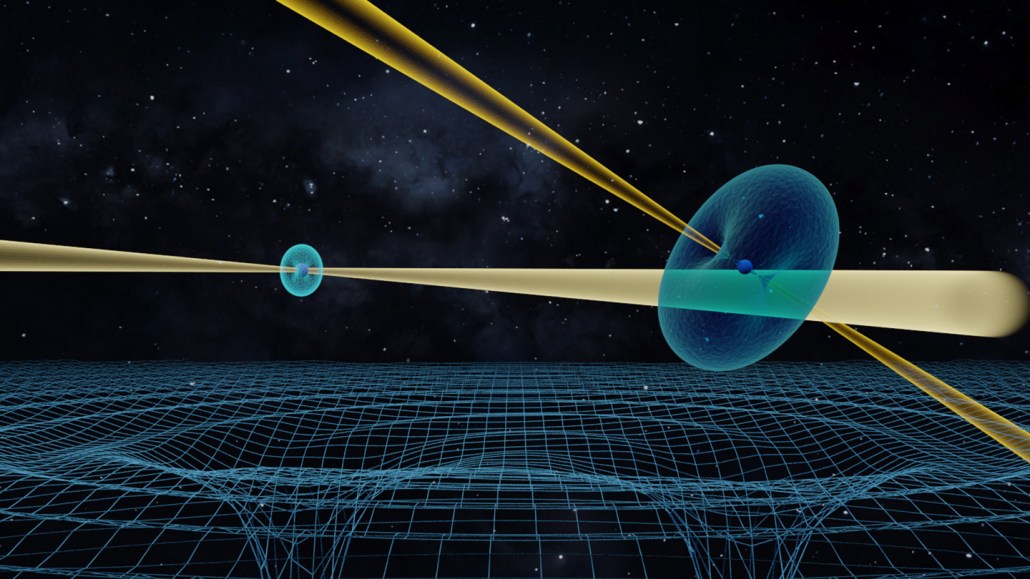
As they spin, two pulsars (blue circles) emit beams of radiation (yellow), channeled by strong magnetic fields (light blue doughnuts). When the beams sweep past Earth, they appear as metronome-like repeating blips. The two pulsars revealed the effects of the warping of spacetime (represented by the grid, bottom) caused by the pulsars, testing Einstein’s general theory of relativity.
© Michael Kramer/MPIfR
- More than 2 years ago
The only known duo of pulsars has just revealed a one-of-a-kind heap of cosmic insights.
For over 16 years, scientists have been observing the pair of pulsars, neutron stars that appear to pulsate. The measurements confirm Einstein’s theory of gravity, general relativity, to new levels of precision, and hint at subtle effects of the theory, physicists report in a paper published December 13 in Physical Review X.
Pulsars, spinning dead stars made of densely packed neutrons, appear to blink on and off due to their lighthouse-like beams of radiation that sweep past Earth at regular intervals. Variations in the timing of those pulses can expose pulsars’ movements and effects of general relativity. While physicists have found plenty of individual pulsars, there’s only one known pair orbiting one another. The 2003 discovery of the double-pulsar system, dubbed J0737-3039, opened up a new world of possible ways to test general relativity.
One of the pulsars whirls around roughly 44 times per second while the other spins about once every 2.8 seconds. The slower pulsar went dark in 2008, due to a quirk of general relativity that rotated its beams out of view. But researchers kept monitoring the remaining visible pulsar, combining that new data with older observations to improve the precision of their measurements.
Now, astrophysicist Michael Kramer of the Max Planck Institute for Radio Astronomy in Bonn, Germany, and colleagues have dropped an exhaustive paper that “just lays it all out,” says physicist Clifford Will of the University of Florida in Gainesville. “To me, it’s just magnificent.”
Here are five insights from the new study:
1. Einstein was right, in so many ways.
The pulsar duo allows for five independent tests of general relativity in one, checking whether various properties of the orbit match predictions of Einstein’s theory. For example, the researchers measure the rate at which the orbit’s ellipse rotates, or precesses, to see if it agrees with expectations. All of the parameters fell in line with Einstein.
What’s more, says astrophysicist Scott Ransom of the National Radio Astronomy Observatory in Charlottesville, Va., “each of the individual tests of general relativity have gotten so precise that … higher-order effects of general relativity have to be included to match the data.” That means that the measurements are so exacting that they hint at subtle peculiarities of gravity. “All of those things are really amazing,” says Ransom, who was not involved with the research.
2. Gravitational waves are sapping energy.
The observations reveal that the pulsars’ orbit is shrinking. By measuring how long the pulsars take to complete each orbit, the researchers determined that the pair get about seven millimeters closer every day.
That’s because, as they orbit, the pulsars stir up gravitational waves, ripples in spacetime that vibrate outward, carrying away energy (SN: 12/18/15). This telltale shrinkage was seen for the first time in the 1970s in a system with one pulsar and one neutron star, providing early evidence for gravitational waves (SN: 12/16/78). But the new result is 25 times as precise as the earlier measurement.
3. The pulsar is losing mass and that matters.
There’s a subtler effect that tweaks that orbit, too. Pulsars gradually slow down over time, losing rotational energy. And because energy and mass are two sides of the same coin, that means the faster pulsar is losing about 8 million metric tons per second.
“When I realized that for the first time, it really blew me away,” says Kramer. Although it sounds like a lot, that mass loss equates to only a tiny adjustment of the orbit. Previously, scientists could neglect this effect in calculations because the tweak was so small. But the measurement of the orbit is now precise enough that it makes sense to include.
4. We can tell which way the pulsar spins and that hints at its origins.
By studying the timing of the pulses as the light from one pulsar passes by its companion, scientists can tell in what direction the faster pulsar is spinning. The results indicate that the pulsar rotates in the same direction as it orbits, and that provides clues to how the pulsar duo formed.
The two pulsars began as neighboring stars that exploded, one after the other. Often when a star explodes, the remnant it leaves behind gets kicked away, splitting apart such pairs. The fact that the faster pulsar spins in the same direction it orbits means the explosion that formed it didn’t give it much of a jolt, helping to explain how the union stayed intact.
5. We have a clue to the pulsar’s radius.
Gravitational effects are known to cause the orbit’s ellipse to precess, or rotate, by about 17 degrees per year. But there’s a subtle tweak that becomes relevant in the new study. The pulsar drags the fabric of spacetime behind it as it spins, like a twirling dancer’s twisting skirt, altering that precession.
This dragging effect implies that the faster pulsar’s radius must be less than 22 kilometers, an estimate that, if made more precise with future work, could help unveil the physics of the extremely dense neutron star matter that makes up pulsars (SN: 4/20/21).
“The authors have clearly been very meticulous in their study of this amazing system,” says astrophysicist Victoria Kaspi of McGill University in Montreal. “It is wonderful to see that the double pulsar … indeed is living up to its unique promise.”







